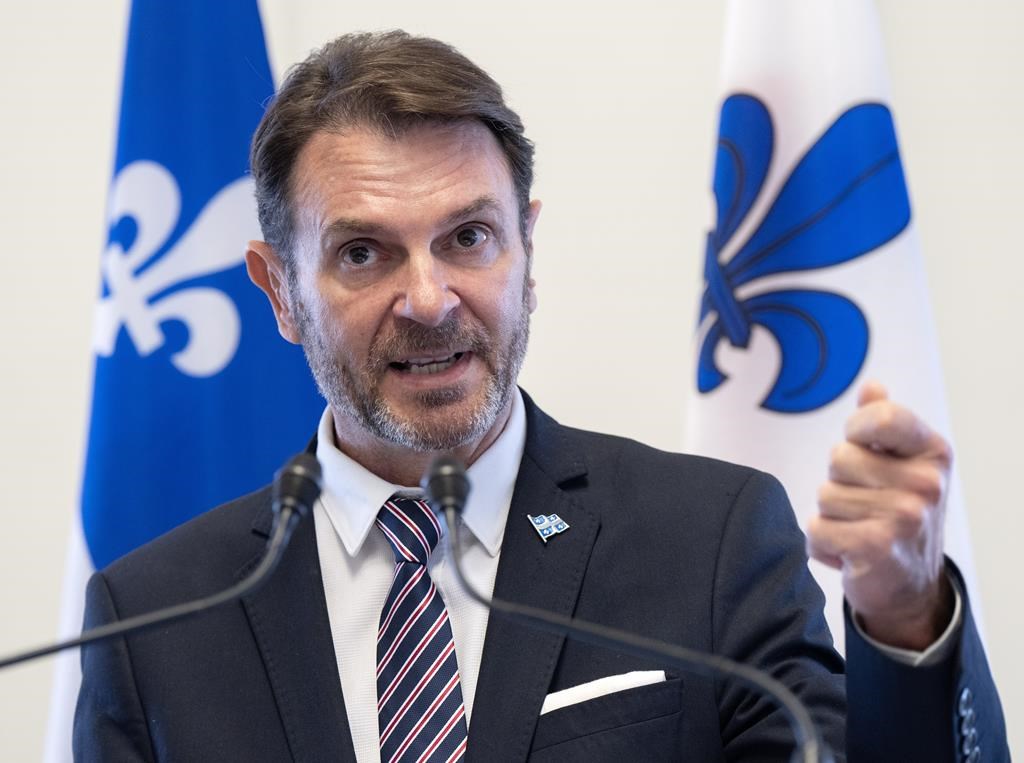Trump tariff threats: Quebec’s Bonnardel wants to tighten border security

Posted December 3, 2024 5:14 pm.
Donald Trump’s threats are weighing heavily north of the border, as Quebec’s Minister of Public Security François Bonnardel gave the impression Tuesday of a man who did not want to displease his powerful southern neighbour following a meeting with police and border authorities – both Canadian and American.
The U.S. president-elect cited the crossing of “illegal migrants” and drugs, more specifically fentanyl, at his borders to justify his intention to impose 25 per cnet tariffs on all Canadian and Mexican products entering the United States.
The participants in Tuesday’s meeting came from the Sûreté du Québec (SQ), the Royal Canadian Mounted Police (RCMP), the Canada Border Services Agency (CBSA). On the American side was the U.S. Border Patrol the Homeland Security Department and the Bureau of Alcohol, Tobacco and Firearms.
Bonnardel stated, at the end of this meeting, “that the situation is currently under control” at the border, after having referred for the first time to the “concerns that the president-elect named a few weeks ago.”
‘Aware of Trump’s message’
In the following minutes, questioned specifically about Donald Trump’s threats to mass deport people in the United States without legal status, he repeated that “everyone is aware of the situation, everyone is aware of the message that is being sent by the president-elect. We are still left with elements of uncertainty that could arise in the coming months, the coming weeks.”
For the time being, Bonnardel was reassuring, stating that “there is no information from the intelligence side that the RCMP gives us, the SQ, that our American colleagues give us, there is no information that indicates to us that there could be a significant flow of migrants that could cross from the U.S. side to Canada, to Quebec.”
The minister said he expected to quickly receive the federal plan announced by Prime Minister Justin Trudeau to tighten security at the border, adding he hoped that “the resources would be adequate to properly protect the border.”
Marked increase in illegal entries into the U.S.
However, Bonnardel admitted illegal crossings to the United States have been increasing sharply for three years and have already reached the 25,000 mark in 2024, including 19,000 in the corridor between Cornwall and Sherbrooke, therefore mainly on the Quebec portion of the Canada-U.S. border.
“It’s an increase that we must say is still quite significant in the last three years for the Quebec portion. … We went from 600 to nearly 7,000, to nearly 19,000 in a horizon of about 24 months. So the migratory flow … from Canada to the United States is still quite significant.”
It should be noted that a large number of these crossings are attributable to nationals from India. Also, authorities have difficulty understanding that, among these illegal entries, “there are still legal ones. There are people with permanent status in Canada, strangely, who decide to want to cross illegally,” the minister said.
Conversely, Bonnardel did not give an overall figure, but spoke of approximately 150 crossings per week at Lacolle, which means 7,800 crossings on an annual basis for this border post alone. But he maintained that this is a “situation that is stable for border agents.”
‘Very lucid’
Bonnardel repeated several times that he “remains very lucid,” adding that there are “elements of uncertainty that are important. We cannot predict what will happen in the coming months, if not the coming weeks.”
He also repeatedly stated a message that will undoubtedly be well received in Donald Trump’s offices, namely that “what is important is that the border be protected, well protected in both directions.”
He believes that this protection will be ensured by the CBSA on the front line, the RCMP on the second line and finally the SQ on the third line in border municipalities.
He added that the federal government gave him assurances “that they are able to respond as quickly as possible if there were more migrants, so be able to move personnel everywhere in the eastern territory, in any case in eastern Canada.
“There is a migratory flow at the moment that is increasing significantly between Canada and the United States. They told us that the numbers had increased. So, on that, when I say that we must protect the border in both directions, it is in both directions. … As much as we do not want to see a migratory flow from the United States to Canada, our friends, our American partners want the same thing on the other side. The effort must come from both parties.”








